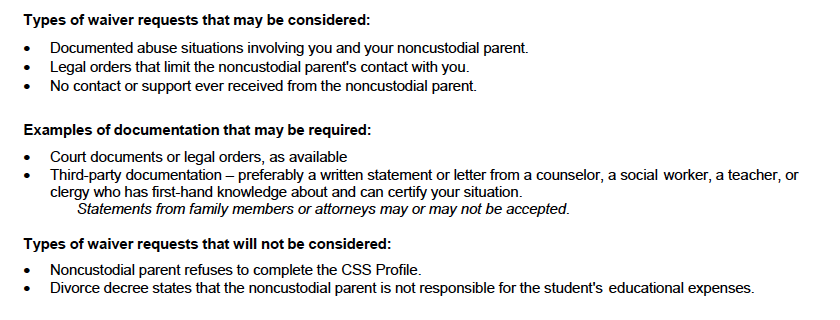Students and parents applying for financial aid will complete a new, simpler FAFSA (Free Application for Federal Student Aid) for the 2024-25 academic year. The new FAFSA greatly reduces the number of questions and makes it easier for students and families to file.
Student Aid Index (SAI) will replace Expected Family Contribution (EFC) as the calculated amount a family is able to pay for a student’s college for a given year. Colleges will use SAI in place of EFC in the fundamental equation to determine need-based financial aid eligibility.
Cost of Attendance – Student Aid Index = Financial Need
Your financial need is the amount of need-based financial aid you would be eligible for.
Along with the new terminology, there are changes to how a family’s eligibility is calculated. Here are the five most important changes you need to be aware of and how they may impact you.
1) Elimination of the number of students in college
Change
The most discussed – and maligned – change is that the formula no longer divides Student Aid Index (SAI) by the number of students in college. Previously, the Expected Family Contribution (EFC) was calculated as a family’s ability to pay for all college costs for a single academic year. If there were multiple children in college, this EFC was then divided among those children so that each student was expected to pay a portion of the total EFC. Now, the SAI will be calculated equally for each student, except for differences in student income or assets reported between siblings.
Impact
Families with multiple children in college at the same time will see an increase in their SAI over previous years’ calculations, reducing their eligibility for financial aid.
2) Limits on income reported
Change
Income reported on the FAFSA will only come from federal tax returns. Parents (or students) will no longer be required to report untaxed or pre-tax income not captured by the tax return. Most notably, pre-tax contributions to employer retirement plans will not be counted. For student income, there is no longer the requirement to report money received or bills paid on their behalf by relatives or others.
Impact
Parents who want to lower their SAI and increase aid eligibility and may now consider maximizing pre-tax employer retirement contributions to reduce the income reported on FAFSA.
Students can now receive money from relatives – grandparents and others – to help pay for college without that support having a negative impact on their future aid eligibility.
3) Child support now reported as an asset
Change
Child support will no longer be reported as untaxed income, but instead, the amount of child support received in the FAFSA tax year will be reported as a parent asset.
Impact
Divorced parents receiving child support may see an increase in their aid eligibility since the contribution rate to the Student Aid Index (SAI) from parent assets is much lower than from parent income.
4) Value of a family business or farm is reported as a parent asset
Change
The net worth of a family business or farm of any size will now be reported as a parent asset. The current EFC formula excludes this amount if the business or farm employs fewer than 100 full-time employees, which exempted most cases. Going forward, this change may impact more small business owners.
Impact
Families who report a value to their business or farm will see a higher Student Aid Index and a decrease in their aid eligibility. It’s important to note that the total value reported will not be counted as a parent asset, but only a portion. This 2024-25 chart details how this included amount will be calculated.
| If the net worth of a business or farm is… | Then the adjusted net worth is… |
|---|
| Less than $1 | $0 |
| $1 to $165,000 | 40% of net worth of business/farm |
| $165,001 to $490,000 | $66,000 + 50% of net worth over $165,000 |
| $490,001 to $820,000 | $228,500 + 60% of net worth over $490,000 |
| $820,001 or more | $426,500 + 100% of net worth over $820,000 |
5) New rules to calculate an SAI equal to $0
Change
There are new thresholds for students to qualify for an SAI equal to $0 and receive the maximum Pell Grant. A parent’s Adjusted Gross Income (AGI) in the FAFSA tax year will be compared to a multiple of income for Federal Poverty Level for their marital status, family size and state of residence. If the parent’s AGI falls at or below this amount, then a student will be given a maximum SAI equal to $0 and awarded a full Pell Grant. Here is the 2024-25 chart with income thresholds by marital status and family size for the lower 48 states.
Family size/
members of household | Single parent with AGI at or below | Married parent with AGI at or below |
|---|
| 2 | $41,198 | N/A |
| 3 | $51,818 | $40,303 |
| 4 | $62,438 | $48,563 |
| 5 | $73,058 | $56,823 |
| 6 | $83,678 | $65,083 |
| 7 | $94,298 | $73,343 |
| 8 | $104,918 | $81,603 |
SAI can also be as low as -$1,500 as a measure of extreme need. Any student whose parent is not required to file a tax return will be given an SAI equal to -$1,500; however, there are other scenarios where a student’s SAI will be less than $0.
Impact
For families with high need, a better opportunity to receive an SAI equal $0 and the maximum Pell Grant. The new methodology is more generous and flexible than today’s “automatic $0 EFC” income threshold of $29,000 or less.

